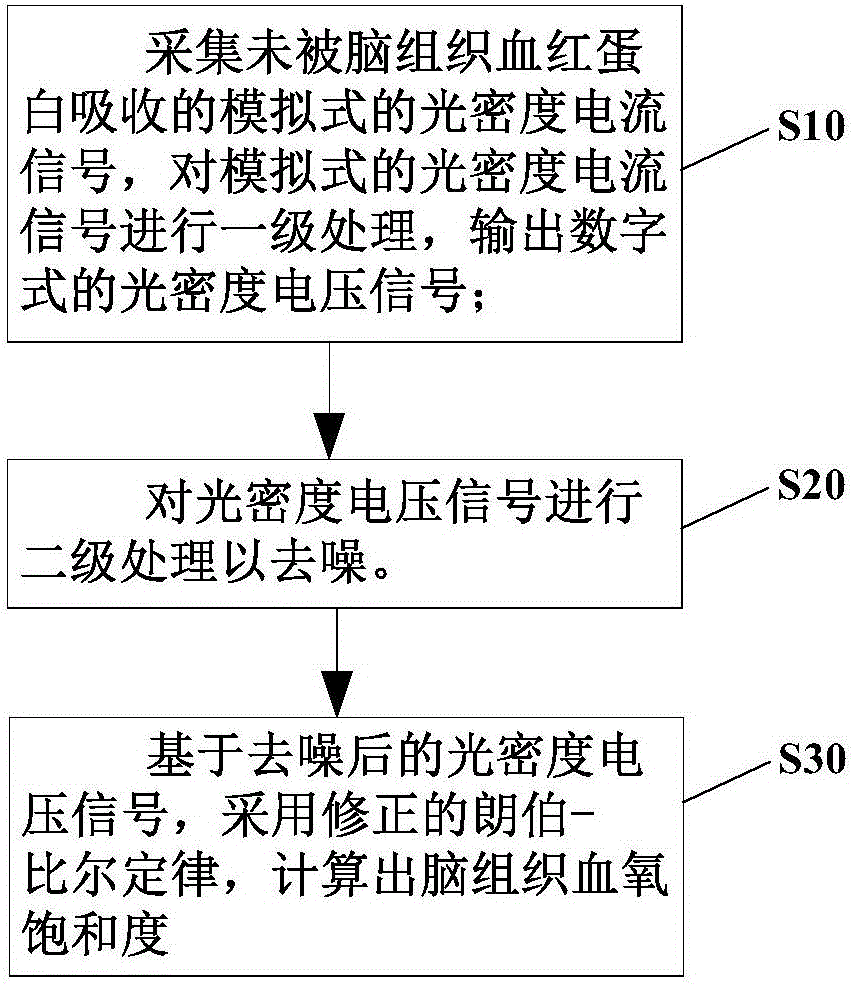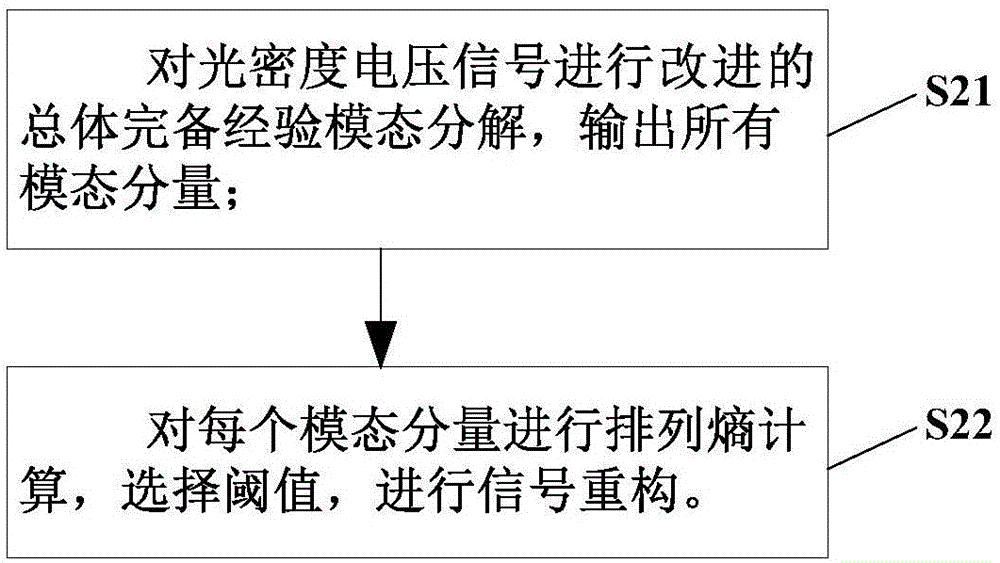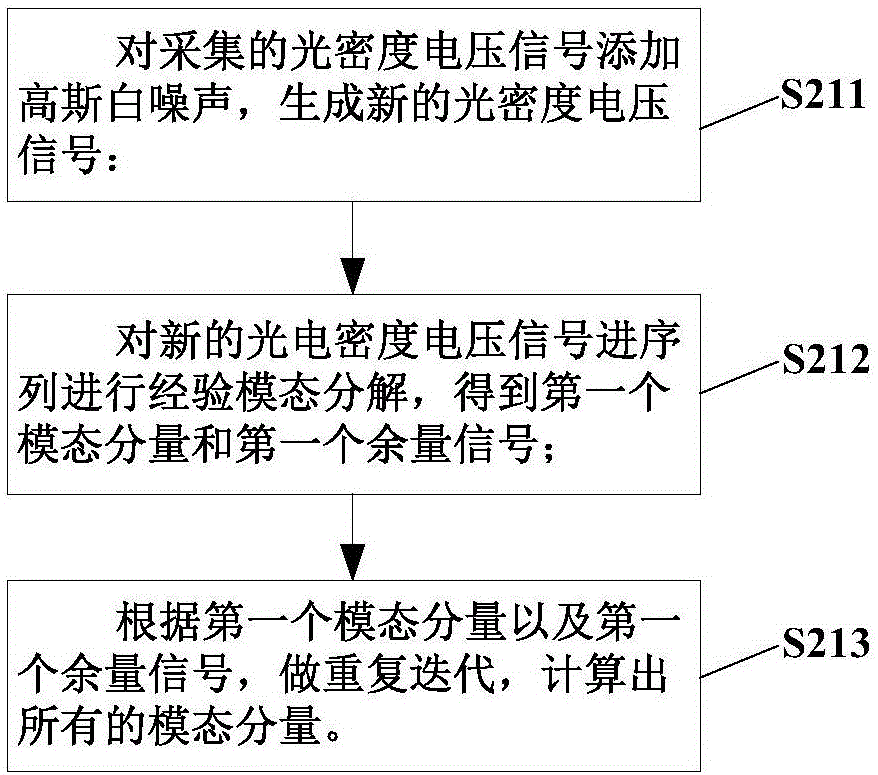Cerebral blood oxygen detection signal processing method and system
A signal processing and detection system technology, applied in the field of cerebral blood oxygen detection, can solve the problems of high operating voltage, reduced sensitivity, large volume, etc., to achieve the effect of improving accuracy, reducing the effect of baseline drift and high-frequency noise
- Summary
- Abstract
- Description
- Claims
- Application Information
AI Technical Summary
Problems solved by technology
Method used
Image
Examples
Embodiment 1
[0057] Such as figure 1 As shown, the present invention provides a signal processing method for cerebral blood oxygen detection, which includes the following steps:
[0058] S10, collecting analog optical density current signals not absorbed by brain tissue hemoglobin, performing primary processing on the analog optical density current signals, and outputting digital optical density voltage signals;
[0059] S20, performing secondary processing on the optical density voltage signal to denoise;
[0060] Among them, such as figure 2 As shown, secondary processing includes the following steps:
[0061] S21, improving the overall complete empirical mode decomposition of the optical density voltage signal, and outputting all modal components;
[0062] S22. Perform permutation entropy calculation for each modal component, select a threshold, and perform signal reconstruction.
[0063]In the above embodiments, the primary processing is used to convert the analog optical density ...
Embodiment approach
[0079] As another embodiment of the present invention, the signal processing method for cerebral blood oxygen detection further includes the following steps:
[0080] S30, based on the denoised optical density voltage signal, using the modified Lambert-Beer law to calculate the blood oxygen saturation of the brain tissue. Such as Figure 5 As shown, specifically, the following steps are included:
[0081] S31, based on the modified Lambert-Beer law, calculate the hemoglobin concentration and blood oxygen saturation:
[0082] Among them, OD is the optical density; I Out Indicates the transmitted light intensity; I In Indicates the intensity of incident light; ε indicates the molar absorptivity; C indicates the concentration of light-absorbing substances; L is the effective path length;
[0083]
[0084] S32, bring in the denoised optical density voltage signal, and calculate the oxygenated hemoglobin concentration and deoxyhemoglobin concentration C Hb ;
[0085] S...
Embodiment 2
[0088] On the basis of the signal processing method of cerebral blood oxygen detection provided in embodiment 1, such as Figure 6 As shown, the present invention provides a cerebral blood oxygen detection system, comprising:
[0089] Optical density signal collection module 10, which is used to collect analog optical density current signals that are not absorbed by brain tissue hemoglobin;
[0090] Signal processing and operation module 20, which is connected to the optical density signal acquisition module for communication, and is used to perform primary processing, secondary processing, and calculation processing of brain tissue blood oxygen saturation on the analog optical density current signal; and,
[0091] A display module 30, which is connected to the signal processing and computing module for displaying the blood oxygen saturation of the brain tissue;
[0092] Among them, the first-level processing includes sequential current-voltage conversion, low-pass filtering,...
PUM
 Login to View More
Login to View More Abstract
Description
Claims
Application Information
 Login to View More
Login to View More - R&D
- Intellectual Property
- Life Sciences
- Materials
- Tech Scout
- Unparalleled Data Quality
- Higher Quality Content
- 60% Fewer Hallucinations
Browse by: Latest US Patents, China's latest patents, Technical Efficacy Thesaurus, Application Domain, Technology Topic, Popular Technical Reports.
© 2025 PatSnap. All rights reserved.Legal|Privacy policy|Modern Slavery Act Transparency Statement|Sitemap|About US| Contact US: help@patsnap.com



